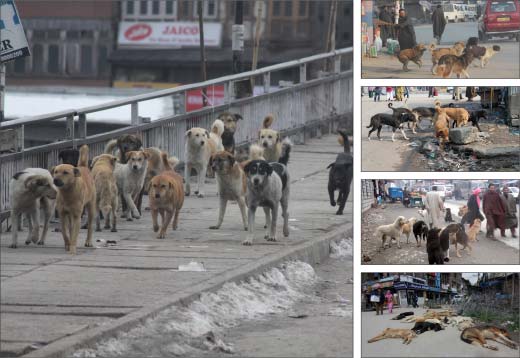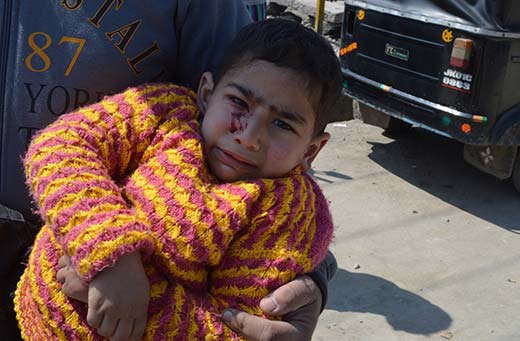Despite official claim of reducing dog population to half in just two years canines are on the loose and stronger than ever. Syed Asma reports the quantum of menace that has left a generation bitten and bruised

Pic: Bilal Bahadur
It was pitch dark when 62-year-old Mohammed Shafi left for home. A resident of Lal-Bazar he was out to offer Isha – the fifth prayer – of the day. On way home, he stopped by a small local grocery shop. Shopped, chattered for a while and left. While on his way home he found a pack of dogs sitting silently in a corner. Shafi did not bother them and moved ahead.
A few minutes passed, he noticed a dog following him. Without panicking, Shafi continued to walk at same pace, “I thought if I ran he will get violent and may attack.” The dog suddenly started barking, Shafi ran, the dog ran faster and came in front of Shafi. The dog jumped at him. Shafi, fell on the ground and the pack of dogs attacked him.
It took him15 minutes to save himself from them. “I kicked them, pelted stones and threw at them whatever came in my hand and finally ran away,” Shafi remembers. His whole body was bruised and received injuries including on his face and mouth. His lips were torn and received 10 stitches.
The dogs tried to attack his throats but his long beard saved him, doctors had told him.
Shafi is undergoing treatment. It has been a month already and the treatment may continue for one more month.
Later when the news of Shafi’s injuries spread, it came to light that Shafi was not the only one attacked that day. He was among half a dozen people including women and children who were injured by the same pack of dogs on the same day.
Even kids were not spared by the canine breed.
Aqib, a 13 year old boy was accompanied by his mother. He, a mentally challenged young boy has been advised by the doctor to take a walk in the evenings, so his mother accompanies him.
Last evening, following their normal schedule, the mother-son duo was out to take a walk. While coming back to their home, the duo passed through a pack of dogs. “Every day we would pass through the same spot and were never annoyed by those dogs,” says Asiya, Aqib’s mother. “But yesterday they looked furious, so I avoided our normal route and took another route, comparatively longer one.” The dogs perhaps didn’t like their idea and followed the duo and attacked. Though, the mother wasn’t bitten but was dragged with her dupatta and Aqib was bitten on his leg and abdomen.
Doctors have advised Aqib’s parents to keep a check if he [Aqib] shows some Rabies symptoms. “The anti-rabies treatment is on but I am worried for the fear psychosis Aqib is being through. He doesn’t eat and sleep properly.”
From 2009 till present 31,056 dog bite cases have been registered in SMHS’s Anti Rabies Centre. The latest data, from April 2014 to March 2015, shows that 4702 dog bite cases were registered in SMHS.
Last year, in 2013, it was 6051. In 2012, the number was reduced to 5390 from 2011’s 7002.
In 2010 and 2009, the number was comparatively less as 3711 and 4200 respectively.
Officials flaunting the decreasing number of canine causality say that initiatives like ‘clean and green city’ and sterilization of the breed are the major reasons.
Dr Javaid Ahmed Rather, the veterinary officer in Srinagar Municipal committee (SMC) says, “Proper dumping of garbage and sterilization of dogs are two successful programs that helped to control canine population in the city and reduce the number of attacks.”
In past three years, the population of dogs is reduced to almost half in Srinagar. The year 2011 census shows the city had 90,000 dogs and the November 2013 census shows the number is reduced to 49,000 dogs.
The state started working on the menace after the high court took cognizance in September 2011.
State High Court in response to a PIL, filed by an NGO, directed SMC to start working on controlling the population of canine species in collaboration with the Animal Welfare Board of India (AWBI) and SKAUST Kashmir.
Abiding by the directions of high court, the first MoU between AWBI, SMC and SKAUST was signed in May 2012. It was directed that AWBI will share the costs of the project equally and SKAUST will provide the required land and expertise.
“In the first phase, almost Rs 1.03 crore was spent on the project” informs Dr Rather, “In the first year we were able to do 1000 sterilization, which is a significant number.”
But later in winters AWBI asked to put a hold on the project as they feared dog deaths due to hypothermia (cold shock).
The contract, between the same parties, was supposed to get renewed after a year but AWBI intervened on its own and disengaged SKAUST for “some unknown reasons”. Later a new MoU was signed between SMC, AWBI and an International NGO, Humane Society International (HSI) in April 2013.

Pic: Bilal Bahadur
Though an international NGO was introduced to have better results but it proved adverse. Against the target of 5000, the new combination was able to sterilize only 463 dogs which is comparably a weak performance.
“September floods and local elections are the reasons for weak results,” justifies Dr Rather.
The contract with HSI ended in September 2014 and SKAUST is likely to join the team back if state gives a nod for the proposal submitted by them.
Dr Rather elaborates; the dog population is also controlled by a proper management of the garbage across the city.
Srinagar city has at least 1500 poultry outlets, wherein 1 lakh poultry birds are slaughtered per day which leave 40,000 Kgs of waste. Besides, 3000-4000 animals are slaughtered a day leaving an ample amount of waste behind.
“Without its proper management, it wasn’t possible to control the dog menace in the city. We are working on even better management for comparatively better results,” says Dr Rather.
It is said that two decades ago the dog menace was too low as the waste management, especially the waste of animals, was managed in a better manner.
Presently, the animals and poultry birds are slaughtered in privately owned slaughtered centres unlike yesteryears when the slaughterhouses were managed by the state.
“Then accountability and waste management was far better than the present,” says a retired employee of SMC.
Presently, no state owned slaughter centres exist in Valley. And it is the left-over waste of animals that becomes the main ingredient in the feed of canine population across Kashmir.
Seeing the importance of a slaughter houses SMC is spending a sum of Rs 37 Lakhs building a new one at Tengpora. But no such proposals are in pipeline for rest of the Valley.
Though, the number of dog bite cases seems to be decreasing in Srinagar but outside the city they remain the same. If locals are to be believed the numbers are on a rise.
No dog census has ever been done outside Srinagar; instead the locals allege that the trucks loads of dogs are unloaded in the villages near to the national highway in both south and north of the Valley. However, the authorities don’t own it but a few eye-witnesses have their accounts how the truck loads of dogs get unloaded during night.
Recently, two children were mauled to death by a pack of stray dogs in Lacchipora, Handwara. The two were attacked in mid-afternoon while they were out in the field to play.
The death triggered protest in the whole village. The protesters chanted slogans and alleged that the government has failed to provide security to the people, especially children, from dreadful canines.
South of the valley too is not spared. “We have a lot of children who were attacked by dogs in our village, a few were mauled to death. Recently a 7-year-old boy was attacked by dogs and got 20 stitches on his head,” says Ghulam Ahmed, a resident of Bijibehra, Anantnag.
Ahmed complains that a heap of garbage just a mile away from his home is turning out to be a misery. “I don’t know how I saved my three year son yesterday from the pack of dogs,” says Ahmed.
It’s not only the heaps of garbage that breeds dogs but the high protein left-overs in and around the Army camps also play a boon for the growth in their [dog] population.
“Haven’t any of you noticed,” asks Ghulam Mohammed, “the areas in and around army camps have a huge dog population?”
Ghulam Mohammed is a resident of Lal Bazar, adds, “It is because of the CRPF camp in Lal bazar and Malibagh who dump their tamed dogs in the area to restrict our movements during nights”.
“I have myself once seen their (CRPF) truck dumping dogs in the nearby play field,” says Ghualm Mohammed. He had seen this during his morning walk.
Apart from leaving their tamed dogs in the nearby localities the army has identified a spot in Barosa, Pulwama as a dumping site for the garbage generated within their camps. It is operational since last few years and has become a nuisances for the locals living around.
“Apart from foul smell, increased population of dogs and flies, the dumping site would have effects on the saffron land around this garbage spot,” says Altaf Hussain, a resident of Basora.















